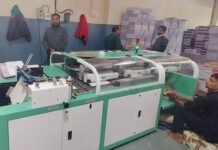
Purva Rai and Naresh Khanna
IppStar’s research team (www.ippstar.org) has looked at the financial performance of a cohort of Indian monocarton companies from the financial year 2017-18 to the financial year 21-22, which is the latest financial year for which data is available. Our sample cohort consists of seventeen companies that may be considered a substantially representative sample of the top of the industry’s pyramid. The top five companies in our sample have turnovers above Rs. 200 crore, while the bottom five have turnovers that range from Rs 45 crore to Rs 90 crore.

17 Indian monocarton companies in FY
2021-22. Copyright IPP Services, Training
and Research PL 2023 www.ippstar.org
Most of our sample cohort supply monocartons for all FMCG segments including food, alcobev, and pharma products – although four may be considered specialists in pharma packaging. One could say that all supply litho-laminated cartons – printed board pasted on micro-fluted liners while several converters also produce luxury cartons for confectionary and cell phones.
Of our seventeen monocarton producers, two are also producers of flexible packaging, while five produce labels too, and almost all produce corrugated cartons in-house for the transport packaging of their materials. Nine of the companies in our sample have plants in two or more regions of the country. The majority of our sample has continuously added capacity in the last several years.
Although our sample doesn’t include several leading carton producers in the country including some that are both large and multilocational, it is representative of companies whose financial data are accessible and up to date. Notably, while several companies have equity investors, only one company in our sample is a joint stock company quoted on the Indian stock exchanges.

Indian monocarton companies in FY 2021-
22. Copyright IPP Services, Training and
Research PL 2023 www.ippstar.org
What the quick review of the reported financial figures of our sample cohort shows is that their combined EBITDA which started out at 13.2% as a percentage of revenue in FY 17-18, dipped slightly in the two following years and resumed growth to reach 14.7% in FY 20-21. Subsequently, their combined EBITDA again dipped to 13.5% in FY 21-22. Over the reported five years the combined profit of the seventeen companies doubled from approximately Rs 100 crore to over Rs. 200 crore.
Nevertheless, for several companies in our sample, FY 20-21 was healthier in terms of their EBIDTA than 21-22. This, as our accompanying graph (Figure 1) shows, can be attributed to the lower human resource costs in FY 20-21 and their increase in a single year by 9.45% in FY 21-22.
Moreover, the combined EBITDA as a percentage of total revenue also declined significantly in FY 21-22 over the previous year, going from 14.7% of total revenue to 13.5%. However, profits rose by more than 50% in FY 21-22 in comparison to the previous year while the combined turnover of our sample rose by 23.6%. This implies stronger demand and higher efficiencies in spite of spiralling raw material costs.
Entire cohort resilient and profitable in FY 2021-22

Indian monocarton companies in FY 2021-
22. Copyright IPP Services, Training and
Research PL 2023 www.ippstar.org
While in the first four years of our survey, one company recorded a loss in the first year and two companies showed losses in the subsequent three years, all seventeen companies were profitable in FY 2021-22. This seems to reflect the buoyancy of the industry in overcoming the inflationary rise in the costs of raw materials with much better and more productive use of installed capacity over previous years. For the monocarton industry, the pandemic year of FY 20-21 shows a rise in EBITDA and profitability while turnover grew marginally, the consumption of raw materials declined or remained flat, and the cost of employee benefits also dipped slightly.
The few companies whose profitability declined and who we have talked to, say that they were unable to keep up with the successive and continuous increases in the price of raw materials. By the time a higher price was accepted by their customers another increase would compell them to continues supplies at older contracted rates.
The Indian monocarton industry has been resilient and may have regained its growth trajectory in the past year although the graph seems mostly inflationary and invites caution. In the past year, the industry’s capacity expansion has been constrained by the slow shipment of the highly configured multicolor presses ordered from the major manufacturers because of their supply chain and energy dysfunctions. In some cases, these are for projects that were planned two or three years ago.















